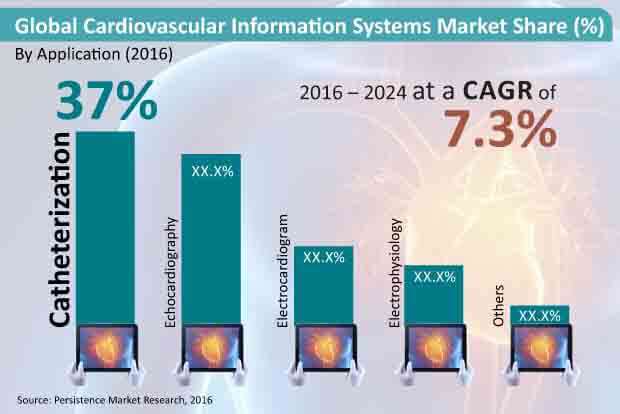Cardiovascular Information System (CVIS) Market Segmented By Hardware, Software, and Services Components on Cloud-based, On-premise Deployment for Catheterization, Echocardiography, Electrocardiogram, Electrophysiology
Industry: Healthcare
Published Date: March-2017
Format: PPT*, PDF, EXCEL
Delivery Timelines: Contact Sales
Number of Pages: 261
Report ID: PMRREP4193
Cardiovascular diseases are the leading cause of death worldwide where in one in three people die each year due to heart disease. According to the CDC foundation 2015 data, approximately 800,000 Americans die due to stroke and other cardiovascular diseases. This has in turn increased the number of imaging systems and the need for centralized data sharing units. The government reforms and incentives to promote the adoption of electronic medical records has propelled the market for Cardiovascular Information Systems (CVIS).
CVIS is more data driven as compared to CPAPS where patient informatics from integrated Hemodynamics systems, Echo machines, EKG/ECG carts and third-party integrated monitoring systems are all stored within the single CVIS database for patient records and reporting. CVIS has the ability to provide dynamic reporting i.e. images, informatics, measurements, etc. that are structured in a template-type format for efficiency and consistent delivery of patient reports.
Persistence Market Research forecasts the global cardiovascular information system market to grow from more than US$ 650 Mn in 2015 to nearly US$ 1,300 Mn by 2024 end. This represents a CAGR of 7.3% over the forecast period. The global market for cardiovascular information systems represents an absolute $ opportunity of more than US$ 45 Mn in 2017 over 2016 and incremental opportunity of more than US$ 600 Mn between 2016 and 2024.
Catheterization is the most widely used application in the CVIS application types with the most streamlined reimbursement policies
Catheterization segment dominated the global CVIS market in revenue terms in 2015 and is projected to continue to do so throughout the forecast period. Catheterization segment is the most attractive segment, with an attractiveness index of 1.8 during the forecast period. Catheterization segment accounted for 37.3% value share in 2015 and is projected to account for 37.1% share by 2024 end.
Echocardiography segment is expected to be the second most lucrative segment in the global CVIS market, with an attractiveness index of 1.7 during the forecast period. Electrocardiogram segment is expected to be the least attractive segment in the global CVIS market, with an attractiveness index of 0.7 during the forecast period.

Hybrid Cath Labs
The type of procedures performed in cardiac cath labs have changed with time and have become more complex – Transcatheter aortic valve replacement (TAVR), transcatheter structural heart repairs such as patent foramen ovale, ventricular septal defects, renal denervation to treat drug-resistant hypertension and left atrial appendage.
Some procedures, especially hybrid coronary revascularizations and TAVR, combined with healthcare reforms, will require new levels of collaboration between various specialists such as surgeons and interventionists. There is a complete transformation and cath labs would no longer be serving cardiologists but many other end users.
Key Regions
Geographically, North America is the leading the global CVIS market. North America dominated the global CVIS market as the region’s healthcare information system (HIT) is experiencing acquisition and federal implementation of Meaningful Use (MU) incentive program as well as other federal mandates such as ICD-10 coding conversion.
The number of HIT vendors are also increasing as there are many niche market players trying to leverage the MU mandate. As economically developing regions such as Latin America are still behind the developed countries, this region has huge potential for market growth, and is likely to be the fastest growing region throughout the forecast period.
Most of the new CVIS platforms are web-based so they are “zero-footprint” with regard to needing a hard drive to house the software, as with traditional workstations. These platforms also eliminate the need to network all the workstations in a department together, as they can transfer data across the web.
This also eliminates the need for tethered workstations, so now staff can work on any web-based computer or mobile device, regardless of their location. Philips recently unveiled its Intellispace CVIS. It uses an icon-based timeline view of a patient’s medical records instead of a traditional text listing of exam files and reports_bk_01_01_2020.”
--- Analyst – Life Sciences & Transformational Health, Persistence Market Research
| Attribute | Details |
|---|---|
|
By Components |
|
|
By Deployment |
|
|
By Application |
|
|
By End User |
|
|
By Region |
|
To know more about delivery timeline for this report Contact Sales
